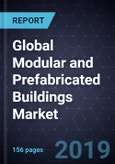Increasing Labor Costs and Construction Timelines are Boosting the Adoption of Prefabricated and Modular Buildings Across the Globe
Modular or prefabricated buildings are made in a factory and installed later at a site, unlike traditionally-constructed buildings, which are built at the site itself. Major materials involved in the market are wood, concrete, steel, and plastics and composites. The modular and prefabricated building market is currently at a nascent stage when compared to traditional building construction; however, the market is developing rapidly and leading to increasing penetration of modular buildings within the construction sector. The market in this study is analyzed for end-industries including residential and non-residential construction. The major end-users are construction contractors, developers, and project owners.
Rising construction spending is expected to drive the growth of the modular and prefabricated buildings market. Apart from this, developers are looking to reduce construction deadlines and decrease the cost of construction. This preference has led to the development of prefabricated and modular buildings, as buildings made in a factory environment utilize less labor and time for overall construction leading to both time and cost savings. Thus, this factor is expected to be a key growth driver for the market. The market currently gains a large portion of its revenue from the non-residential construction segment driven by robust growth due to economic prosperity in various regions. Additionally, significant growth in the development of the commercial construction segment propels the growth of this market in regions such as the Middle-East, Europe, Latin-America, and Asia-Pacific.
Wood is a preferred material for modular and prefabricated construction because it is a recyclable material with comparable strength to concrete and has a lightweight nature that allows for easier installation. However, in Asia-Pacific and the Middle East, the material preference mimics traditional construction; a high volume of steel and concrete is used and is expected to be used during the forecast period.
The market is regulated by International Building Codes related to the construction of prefabricated and modular buildings. Relevant building materials are required to acquire a CE marking in Europe. There is an increasing trend for the construction industry to develop buildings using materials that promote sustainability and recyclability. As a result, building manufacturers are increasingly investing in product development to enhance environmental sustainability and product efficiency as end-users are increasingly looking for products that are durable, sustainable, and regulatory-compliant.
The market is highly competitive among large, global manufacturers in the developed markets of North America and Europe; apart from internal competition, prefabricated manufacturers also face competition from traditional construction participants especially in regions where construction labor is cheap, thereby bringing down the whole cost of construction. The larger market participants increasingly engage in mergers and acquisitions and joint ventures among themselves and with small companies to acquire new products, technologies, and market shares due to which the market points towards further consolidation. Autodesk, a major design software firm, acquired a prefabricated building manufacturer, leading to the further propagation of Design for Manufacturing and Assembly (DfMA) trends in the construction industry.
The market is also impacted by Mega Trends pertaining to the organizing of various events such as the World Expo 2020, Summer Olympics 2020, and the FIFA World Cup 2022, which drive infrastructure growth leading to the growth of modular and prefabricated construction.
Key Issues Addressed
- What is the status of the modular and prefabricated buildings market lifecycle? How is it expected to grow through the forecast period?
- What are the growth opportunities for the different market segments?
- What are the key factors driving and restraining growth in this market?
- What are the key technological developments observed across major segments?
- What are the competitive factors affecting the market and how will the structure of the market change with time?
Table of Contents
Companies Mentioned (Partial List)
A selection of companies mentioned in this report includes, but is not limited to:
- Autodesk
- FIFA








